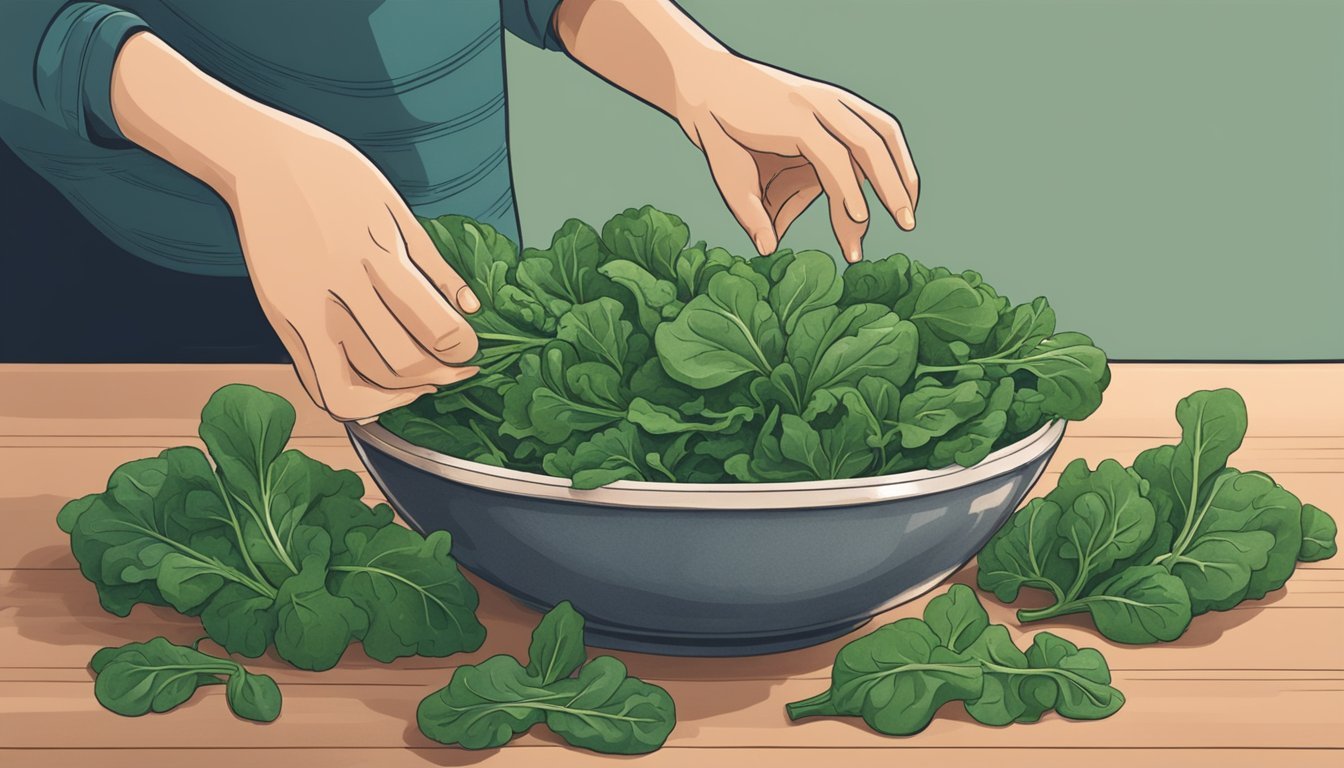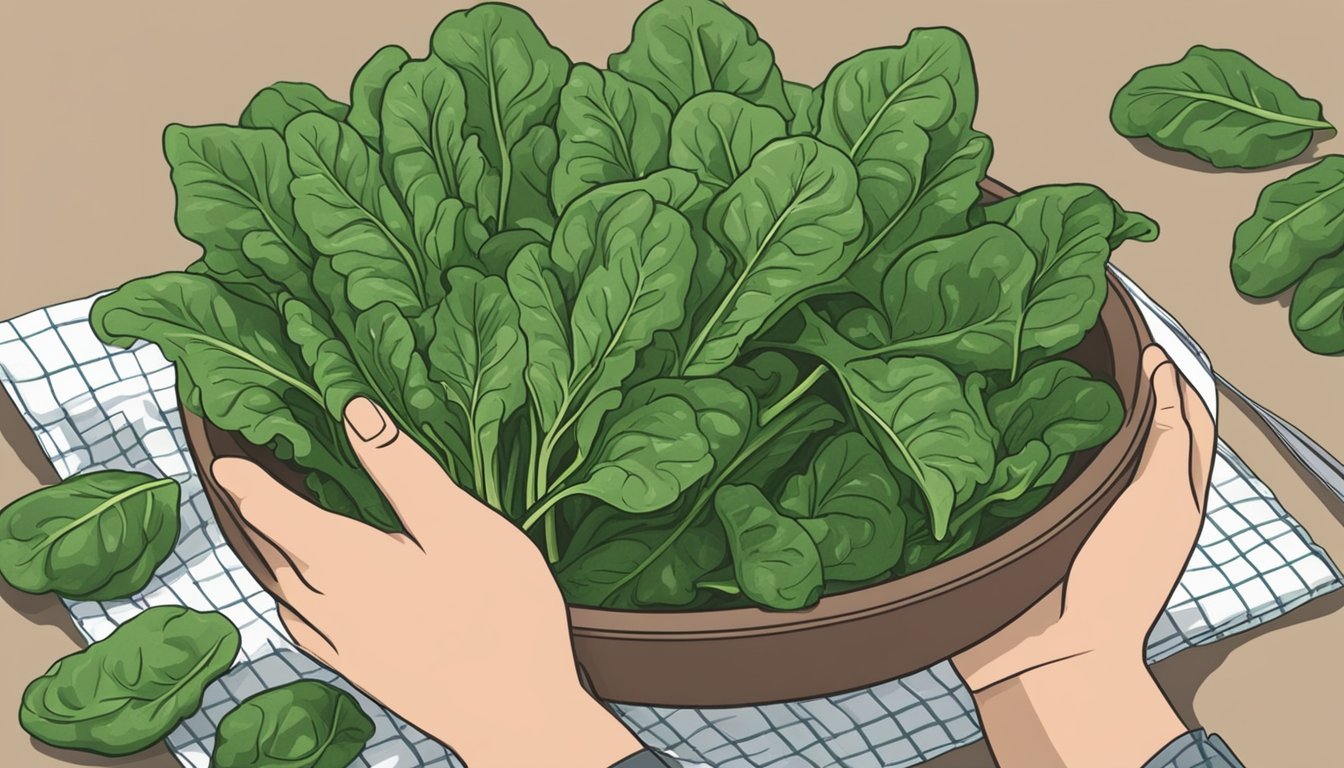How to Substitute Spinach for Kale
A Simple Swap Guide
When considering meal preparation and recipe adaptation, cooks often find themselves seeking appropriate substitutes for certain ingredients, either due to personal preference, dietary restrictions, or availability. Substituting spinach (What wine goes well with spinach?) for kale (What wine goes well with kale?) is a common consideration in the kitchen due to their nutritional similarities and the versatility of both leafy greens. Each brings its own set of characteristics to dishes, yet they can play similar roles in a variety of culinary contexts.
Spinach, with its tender leaves and milder flavor, offers a less pronounced taste and a softer texture compared to the slightly bitter and sturdy nature of kale leaves. This makes spinach an excellent alternative in raw applications, such as salads (What wine goes well with salads?) , where its subtlety complements other ingredients without overwhelming them. Moreover, spinach requires less cooking time than kale, which can be advantageous in quick meals.
In cooked dishes, especially those where kale is called to be simmered or baked, spinach can be incorporated with a few adjustments. Since spinach wilts and reduces in volume significantly, it is often necessary to use a larger quantity of spinach to achieve a similar bulk as one would with kale. Also noteworthy is spinach's nutrient content, as it is rich in vitamins A and C as well as iron and fiber, making it not just a convenient but also a healthful replacement for kale in many recipes.
Understanding Spinach and Kale
In considering how to substitute spinach for kale, one ought to compare their nutritional profiles and taste and texture differences. These factors play a crucial role in how they can be interchanged in various recipes.
Nutritional Profiles
Spinach and kale are both nutrient-dense vegetables, each boasting an impressive array of vitamins and minerals.
Spinach:
Vitamins: High in vitamins A, C, and folate.
Minerals: Rich in iron and potassium.
Fiber: Contains less fiber than kale.
Kale:
Vitamins: Contains more vitamin C than spinach and a generous amount of vitamins A and K.
Minerals: Offers calcium and potassium.
Fiber: Provides nearly twice as much fiber compared to spinach.
Taste and Texture Differences
The taste and texture of spinach and kale differ significantly, which affects how they can be used as substitutes for one another.
Spinach:
Taste: Milder flavor, less pronounced than kale.
Texture: Softer, wilts quickly when cooked, and is easy to blend in smoothies.
Kale:
Taste: Stronger, more bitter flavor profile.
Texture: Tougher leaves that hold up well in cooking and can be massaged to soften for salads.
Preparation Techniques
When substituting spinach for kale, chefs should pay close attention to the preparation steps to ensure that the dish’s texture and flavor are well balanced. Proper washing, drying, cutting, and cooking techniques are crucial for achieving the best results in recipes.
Washing and Drying
Spinach leaves often harbor dirt and grit, so thorough washing is crucial. To wash spinach, one should:
Fill a large bowl with cold water.
Submerge the spinach leaves in the water, gently swishing them around to dislodge any dirt.
Lift the leaves out and into a colander, allowing the dirt to settle at the bottom of the bowl.
Repeat until the water stays clear.
To dry spinach, one can:
Use a salad spinner to remove excess water quickly.
Alternatively, lay the leaves out on a clean kitchen towel or paper towels and gently pat them dry.
Slicing and Chopping
Properly slicing and chopping spinach to match kale’s texture can affect how it integrates into a recipe. Chefs should consider the following:
For raw dishes, like salads, chop the spinach more coarsely to give the dish the hearty texture typically provided by kale.
In cooked preparations, finely chop the spinach since it wilts to a smaller volume compared to kale and cooks more quickly.
Cooking Methods
Chefs can choose various cooking methods for spinach when used in place of kale. These include:
Sautéing: Quickly sauté spinach over medium heat with a little oil until just wilted; typically takes 1 to 2 minutes.
Steaming: Steam spinach for a brief period to retain its vibrant color and nutrients; usually takes about 2 minutes.
Blanching: If a recipe calls for cooked kale, blanching spinach for 30 seconds in boiling water can slightly toughen its delicate leaves, mimicking kale's firmer texture.
By applying these specific preparation techniques, spinach can seamlessly take the place of kale in a variety of dishes.
Substitution Basics
When substituting spinach for kale, one must consider the differences in flavor, cooking time, and texture. Precise adjustments ensure the integrity of the dish is maintained.
Determining Ratios
To replace kale with spinach, the ratio is typically 1:1, meaning if the recipe calls for one cup of kale, use one cup of spinach. However, due to spinach's more delicate nature and higher water content, slight variations may be needed. For example, in raw applications like salads, one might prefer a bit less spinach, as it wilts more quickly.
Adjusting Cooking Times
Spinach cooks more quickly than kale due to its tender leaves. When cooking dishes that originally use kale, reduce the cooking time for spinach. For instance, if a soup recipe includes kale for 15 minutes, spinach should be added in the last 3-5 minutes. Sautéing spinach instead of kale requires just a minute or two, as opposed to kale which might need 5-10 minutes.
Flavor Balancing
Kale has a robust, slightly bitter taste, and spinach offers a milder flavor. To compensate, adjustments in seasoning might be necessary. Use a pinch of salt or a dash of acid like lemon juice or vinegar to enhance the spinach’s flavor. When substituting in recipes where kale's heartiness is a counterpoint to other strong flavors, one might need to increase other herbs or spices to maintain the dish's balance.
Recipes and Pairings
In substituting spinach for kale, it's essential to consider the texture and flavor profile of the dish. The mildness of spinach makes it versatile in a variety of recipes, from thirst-quenching smoothies to hearty casseroles (What wine goes well with casseroles?).
Smoothies and Juices
For smoothies and juices, spinach is an excellent kale substitute due to its softer leaves, which blend smoothly. Recipes like a green detox smoothie can seamlessly incorporate spinach without compromising the vibrant green color and nutrient density. In fact, a typical smoothie recipe might call for a cup of spinach as a direct replacement for a cup of kale.
Soups and Stews
In soups and stews, spinach's gentle flavor and quicker wilting time make it a favorable ingredient for last-minute additions. A soup like lentil spinach soup can benefit from spinach added in the final minutes of cooking, preserving its color and nutrient content. For dishes like minestrone or a hearty bean stew, substitute an equal amount of spinach for kale.
Salads and Dressings
When preparing salads and dressings, spinach's tender quality requires less preparation than kale. It is well-suited for a raw application where its delicacy can be appreciated. For instance, a spinach salad with a tangy vinaigrette can replace a kale salad, where the spinach should be lightly tossed rather than massaged.
Spinach Compatibility Recipe Type High Green salad Moderate to High Caesar salad with a creamy dressing Moderate Warm spinach salad
Casseroles and Baked Dishes
In casseroles and baked dishes such as lasagna or a quiche, spinach can replace kale without major recipe alterations. Casseroles often require cooking greens first, and spinach should be wilted briefly due to its tender nature. For layered dishes like lasagna, spinach can be used fresh or just lightly sautéed before layering. A pasta dish can equally benefit from the substitution, providing a mild, earthy foundation without overpowering other flavors.
Alternative Leafy Greens
When substituting spinach for kale, there are a variety of leafy greens available that can provide similar nutritional benefits and flavors suitable for different types of dishes. Each green comes with its unique characteristics and can be used in a myriad of ways in the kitchen.
Collard Greens and Chard
Collard Greens are robust, leafy vegetables high in vitamins and minerals, such as vitamin K and calcium. Their sturdy texture makes them suitable for longer cooking methods commonly used in Southern cuisines. Chard, including both Swiss chard and rainbow chard, offers a slightly bitter taste and is known for its vibrant colored stems. They can be sautéed, steamed, or added to soups, providing a nutritious boost.
Collard Greens: Best for slow-cooked dishes.
Swiss/Rainbow Chard: Ideal for quick sautés or added to soups.
Mustard Greens and Arugula
Mustard Greens possess a peppery kick which makes them stand out in a dish. They offer a hearty texture similar to kale and can be cooked or used raw in salads. Arugula (how long does arugula last?), also known as rocket, has a distinct nutty flavor. It is commonly used raw in salads but can also be briefly wilted to top pizzas and pastas.
Mustard Greens: Peppery flavor, versatile in both cooked and raw preparations.
Arugula: Nutty and slightly spicy, excellent in salads and as a pizza topping.
Lettuce Varieties
Multiple varieties of lettuce, such as romaine and iceberg, provide alternatives with a crunchier texture but milder flavor. Romaine lettuce, in particular, can be a great stand-in for raw kale in salads and sandwiches. Iceberg lettuce, while less nutrient-dense, offers a refreshing crunch that can be suitable for wraps and salads.
Romaine Lettuce: Crunchy with a mild taste, good for salads and sandwiches.
Iceberg Lettuce: Offers a crisp texture and refreshing taste for wraps.
Exotic Greens
Exotic alternatives include watercress, bok choy, and Chinese broccoli (how long does broccoli last?), each bringing unique flavors and textures that can elevate a dish. Watercress has a slight peppery flavor, much like arugula, and works well in fresh salads or as a garnish. Bok choy, part of the Chinese cabbage family, offers a sweet and mild taste, perfect for stir-fries and steamed dishes. (What wine goes well with steamed dishes?) Chinese broccoli carries a slightly bitter note and is commonly used in Asian cuisine.
Watercress: Peppery and fresh, perfect for salads and garnishing.
Bok Choy: Sweet and tender, suitable for stir-fries and steaming.
Chinese Broccoli: Bitter and robust, good for Asian-inspired recipes.
Special Considerations
When considering substituting spinach for kale, one must take into account potential allergies and dietary restrictions, as well as the availability and seasonality of spinach.
Allergies and Dietary Restrictions
Spinach is generally well-tolerated, but some individuals may have allergies or specific dietary restrictions that make spinach a less suitable choice. It's important to note that spinach has a milder taste and a more delicate texture than kale, making it preferable for those who may have sensitivity to stronger flavors or tougher greens. Individuals should always ensure that spinach is appropriate for their dietary needs.
Availability and Seasonality
Availability: Spinach tends to be widely available in most grocery stores year-round, although its peak season is in the spring and fall. This increased availability can make spinach a convenient substitute for kale.
Season Spinach Availability Kale Availability Spring High Moderate Summer Moderate High Fall High Moderate Winter Moderate High
Seasonality: The delicate texture of spinach may not hold up as well in recipes that require longer cooking times, especially outside its peak season. One should consider if the substitute will be for raw or cooked preparations, as spinach wilts more readily than kale when heated.
Storing and Preservation
When substituting spinach for kale, proper storage methods are essential for maintaining freshness and nutrient quality. Whether for immediate use or long-term preservation, these techniques ensure that the leafy greens retain their characteristics optimally.
Refrigeration Methods
For short-term storage, kale should be kept cool and dry. Storing kale in the refrigerator can keep it fresh and crisp. Users should:
Line a plastic bag with paper towels.
Place the kale inside, massaging it gently with a bit of lemon juice if desired to maintain freshness.
Squeeze out excess air and seal the bag.
Store in the crisper drawer, ideally with stems facing the back where it's coldest.
This method typically keeps kale fresh for up to a week.
Freezing for Longevity
For long-term preservation, both kale and spinach can be frozen. One can successfully freeze kale by:
Blanching leaves in boiling water.
For robust leaves, blanch for three minutes.
For tender leaves, two minutes suffice.
Immediately transferring blanched kale to an ice water bath.
Drying thoroughly with a salad spinner or paper towels.
Laying the leaves flat on a rimmed baking sheet to freeze.
Once frozen, transferring to airtight containers or plastic bags.
Frozen kale and spinach are ideal for use in cooked dishes or smoothies and can be stored for several months.
Innovative Uses and Ideas
When substituting spinach for kale, the culinary possibilities expand with a variety of textures and flavor pairings. This section explores innovative ways to integrate spinach into snacks and dishes, ensuring a delightful experience for your palate.
Kale Chips and Snacks
Making kale chips is a popular, crispy snack option, and spinach can fulfill this role admirably. To create Spinach Chips, one must simply toss leaves in olive oil, sprinkle with sea salt, and bake until crispy. For variations, adding crushed garlic or sprinkled rosemary can enhance the flavor profile.
Bacon & Spinach Crisps:
Lay out spinach leaves on a baking sheet.
Sprinkle with crumbled bacon and bake until crispy.
Lemon & Spinach Chips:
Before baking, add a dash of fresh lemon zest for a zesty twist.
It's vital to adjust cooking times as spinach has a more delicate structure than kale.
Creative Flavors and Combinations
Spinach pairs well with a range of ingredients, creating unique flavor combinations that transform everyday dishes. For instance, goat's cheese & spinach meld for a creamy and tart profile, excellent for stuffing chicken breasts or in omelets.
Bold Pesto:
Combine spinach with olives and garlic, pulsing together with parmesan and nuts for a bold pesto variation.
Savory Spreads:
Mix spinach with tahini for a Middle Eastern-inspired spread, adding a squeeze of lemon to lift the flavors.
The key is to balance the milder taste of spinach with the stronger flavors of these pairings. Experimentation can lead to exciting and nutritious dishes that incorporate all the health benefits of the original kale-based recipes.
Frequently Asked Questions
Can spinach be used in all recipes that call for kale?
Yes, spinach can replace kale in most recipes. However, its softer texture and milder flavor may change the dish slightly. It works well in salads, smoothies, and casseroles.
What adjustments should be made when substituting spinach for kale?
Cooking times may need to be reduced as spinach wilts faster than kale. Additionally, one may need to use more spinach by volume to match the heartier texture of kale.
Is there a difference in nutritional content between kale and spinach?
Both are nutrient-dense, but kale has more vitamin C, while spinach provides more vitamin A and folic acid.
How much spinach should be used to substitute for kale?
For raw dishes: Use a 1:1 ratio by volume, as the leaves reduce significantly when cooked.
For cooked dishes: Since spinach wilts to a smaller volume, start with slightly more than the kale amount, adjusting to preference.
Can I mix spinach and kale in a recipe?
Certainly, one can mix both greens for a varied texture and flavor. Start with equal parts of each and modify according to taste.
What other greens can substitute for kale if I don't have spinach?
Collard greens, cabbage varieties, and Swiss chard are good alternatives, keeping in mind their unique flavors and textures.







